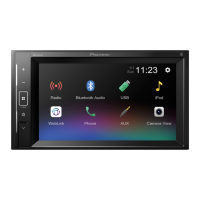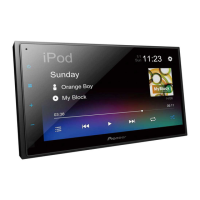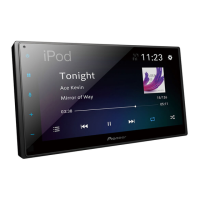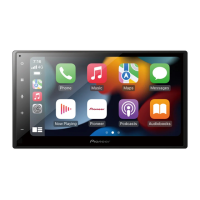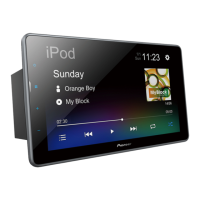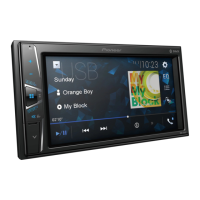Do you have a question about the Pioneer DMH-A241BT and is the answer not in the manual?
Provides guidance on the proper collection and disposal of electronic equipment and batteries.
Details hazards related to improper installation, exposure to liquids, or tampering with the product.
Warns about the dangers of swallowing batteries, emphasizing storage away from children.
Guides users on operating the product safely without compromising driving attention or awareness.
Advises on safe product installation and personal safety measures like seatbelt use while driving.
Explains the function of the handbrake interlock and restrictions on viewing video while driving.
Recommends running the engine to prevent premature battery drain when using the product.
Provides warnings about reversed screen images and cautions against using the rear view function for entertainment.
Advises on safe handling of USB devices to prevent data loss and damage during transfer.
Directs users to the Pioneer website for product registration, software updates, and additional information.
Specifies operational limitations for the product, particularly its use in Europe and Germany.
Provides guidelines for protecting the LCD screen from damage due to sunlight, mobile phones, and improper handling.
Offers notes on interpreting the manual, including screen variations, iPhone designation, and touch screen symbols.
Details the function and location of various controls on the main unit, including volume, power, and display.
Describes the functions of each button on the A241BT remote control for operating the device.
Notes that the remote control for the A240BT model is sold separately.
Explains how to reset the product's microprocessor to factory settings, including conditions and procedure.
Guides users on how to prepare the remote control for use, specifically by replacing the battery.
Provides instructions on how to operate the remote control and factors affecting its performance, like direct sunlight.
Explains how to operate the product using the touch screen and introduces common touch panel keys for navigation.
Explains how to navigate lists by touching items to narrow options or view hidden entries.
Details how to adjust the playback position using the time bar interface.
Identifies and explains the source icons displayed on the top menu screen for accessing various functions.
Shows how to access the product's settings menu using the gear icon on the top menu screen.
Guides users through the steps to connect their mobile device to the product via Bluetooth.
Explains how to use the hands-free phoning feature after connecting a mobile phone via Bluetooth.
Details the process of making phone calls using the product's interface, including accessing the phone menu.
Explains how to manually synchronize contact and call history data from the phone to the unit.
Describes how to select contacts from the phone book and use call history for making calls.
Explains manual dialing and how to answer or end phone calls.
Informs about iPhone voice recognition and switching audio output between devices.
Provides general notes and potential issues related to Bluetooth phone connections and hands-free operation.
Details potential issues with phone book transfers, including entry limits, display errors, and image data compatibility.
Instructs users to register and connect their device to enable Bluetooth audio playback.
Explains the limitations and available operations based on Bluetooth audio profiles (A2DP, AVRCP).
Details the basic controls for audio playback, including play, pause, skip, repeat, and random playback functions.
Lists the various audio-visual sources that can be used with the product.
Guides users on how to select and switch between different AV sources available on the unit.
Explains fundamental radio operations, including recalling presets, tuning, band selection, and utilizing features like BSM and seek tuning.
Explains the Radio Data System (RDS) functions, such as time synchronization, automatic retuning, and traffic announcements.
Provides instructions on how to safely connect and disconnect USB storage devices to the product.
Details the initial steps for starting a USB source, including connecting the device.
Explains the controls for playing audio files from a USB source, including playback management and file selection.
Highlights safety restrictions for viewing video content, requiring the vehicle to be stopped.
Details controls for video playback, including stopping, skipping, repeat options, file selection, and display adjustments.
Outlines operations specific to image files, such as skipping, rotating, and display mode adjustments.
Guides users on connecting their iPhone via USB to enable its functionality with the product.
Explains the basic controls for playback when using an iPhone as a source.
Details how to select specific songs from the iPhone's music list for playback.
Explains how to operate WebLink compatible applications, including installation and copyright considerations.
Warns users about the legality of using smartphone features while driving and advises caution.
Outlines the steps for initiating WebLink functionality with an iPhone.
Details the procedure for starting WebLink with an Android smartphone.
Explains how to launch and operate specific applications within the WebLink interface.
Explains how to display video from devices connected via AUX input, including safety precautions.
Outlines the steps to begin using the AUX input source.
Describes the automatic switching feature to the rear view camera when the vehicle is in reverse.
Explains the Camera View mode, allowing display at all times, with notes on image resizing.
Provides safety advice for camera installation and verification, including image reversal and gearshift verification.
Details the procedure for activating the camera view function.
Explains how to navigate to and open the main settings menu on the product.
Details various system settings, including language, USB connection modes, radio tuning, safety modes, and date/time configuration.
Allows enabling/disabling camera input and managing screen brightness for day/night.
Enables image quality adjustment and restoring product settings to defaults.
Displays firmware version, license, and guides touch panel calibration.
Allows users to select and set the background wallpaper from preset items available on the product.
Enables users to select or customize the equalizer curve and adjust speaker balance.
Details volume adjustments and sound enhancement features like Loudness and Bass Boost.
Allows adjustment of speaker cutoff frequencies and disabling of beep sounds.
Explains how to adjust date/time and restore product settings to defaults.
Details the process for updating the product's firmware using a USB storage device.
Provides solutions for common operational problems, such as a black screen or AV caution messages.
Offers solutions for audio issues and iPhone connectivity problems, including frozen devices.
Addresses problems with the phone screen and application operation, such as unresponsive touch keys.
Addresses smartphone charging issues and guides on interpreting common error messages.
Lists and explains various error messages related to USB storage devices, providing corrective actions.
Details error messages for iPhone, camera, and AUX, along with solutions for no video signal.
Provides general notes and compatibility considerations for USB storage devices and their media files.
Details supported codec formats for audio, image, and video files on USB storage devices.
Outlines compatibility for MP3, WMA, WAV, and AAC file formats, including specific notes.
Discusses compatibility and playback nuances for video files, including character limits and folder handling.
Details video codec compatibility, maximum resolution, and frame rates for various video file formats.
Clarifies folder numbering, and provides trademark information for Bluetooth and WMA.
Details FLAC licensing and provides trademark information for Android and WebLink.
Warns about potential iPhone data loss and damage from prolonged exposure to sunlight and high temperatures.
Advises on handling the iPhone and lists compatible iPhone models and their AV source compatibility.
Outlines the requirements for using app-based connected content, including app version, account, and data plan.
Details limitations on app-based content access, service availability, and provider responsibilities.
Warns that commercial or public viewing may infringe copyright laws.
Provides instructions on proper handling of the LCD screen to prevent damage from sunlight, temperature, and physical contact.
Describes LCD screen characteristics, appearance of dots, and provides cleaning instructions.
Explains the performance of the LED backlight at different temperatures and its estimated product lifetime.
Lists general technical specifications for the product, including power source, dimensions, and weight.
Details display-specific technical parameters, such as screen size, resolution, color system, and operating temperature range.
Specifies audio output power, equalizer frequencies, and gain adjustments.
Lists HPF, LPF, Bass Boost specifications, and Bluetooth version and frequency bands.
Details USB standards, supported file systems, and decoding formats for audio, image, and video files.
Provides technical specifications for the FM tuner, including frequency range, usable sensitivity, and signal-to-noise ratio.
Lists technical specifications for the AM tuner, including frequency range, usable sensitivity, and signal-to-noise ratio.
| Bluetooth | Yes |
|---|---|
| AUX Input | Yes |
| Apple CarPlay | Yes |
| Android Auto | Yes |
| Video Input | Yes |
| Steering Wheel Control | Yes |
| Rear Camera Input | Yes |
| Audio Format Support | MP3, WMA, WAV, AAC |
| Screen Size | 6.2 inches |
| USB Port | Yes (Rear) |
| Power Output | 50W x 4 |
| Preamp Outputs | 3 pairs (front, rear, sub) |
